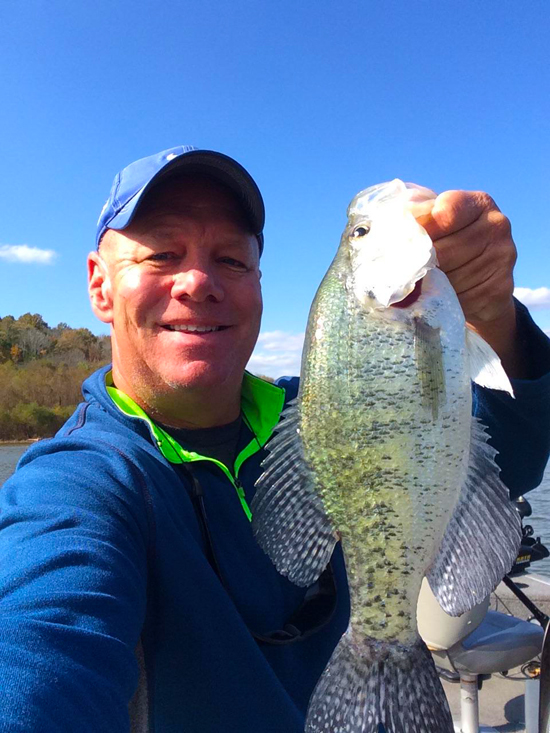BY
(May 17, 2018) – Kentuckians cannot complain about a lack of rain this past spring. It seemed to rain every other day in March and April.

It is a mild miracle the horses running in the recent Kentucky Derby did not sink up to their knees while standing in the starting gate. The 2.31 inches of rain received at Churchill Downs on May 5 set the record for the wettest Kentucky Derby ever.
The bountiful rainfall combined with an unseasonably cool spring have traditional spring fish movements in a bit of a funk. Crappie, largemouth bass and bluegill across the state are in various stages of spawning as water temperatures finally crest 70 degrees on many lakes.
“I think the crappie are spawned out and left the banks at least in the upper lake at Taylorsville Lake,” said Tim Slone, retired former director of the Information and Education Division of the Kentucky Department of Fish and Wildlife Resources. “It’s been a crazy year. There may still be some places where they are not done spawning.”
Slone recently caught 40 crappie from Taylorsville. “All 40 were in 9 feet of water or deeper,” he said. “I had been catching them right on the banks, but now they’ve backed off.”
The same pattern is playing out on Kentucky Lake and Lake Barkley, two of the best crappie lakes in the upper South. Anglers are intercepting them in 7 to 14 feet of water as they move to and from their shallow spawning grounds by drifting tube jigs in red and chartreuse or blue and chartreuse using spider rigs. Anglers slowly trolling small crappie-sized crankbaits in the same depths are also catching crappie. Lake Barkley is fishing particularly well right now.
Largemouth bass are in the process of spawning or just completed spawning across Kentucky. “I fished Beaver Lake recently and saw male largemouth bass up shallow making nests,” said Easton Copley, aquatic education coordinator for Kentucky Fish and Wildlife. “I saw a lot of fish up cruising the bank.”
Copley caught several bass on a 7-inch ribbon tail worm in the green pumpkin color. “All I caught were males,” he said.
With recent weather rivaling mid-summer temperatures, largemouth bass that complete their spawning rituals migrate back toward deeper water. They use channels, stump rows that once lined a pasture fence, ditches, weedlines and old roadbeds as arteries for this movement.
Search baits such as deep-running crankbait in hues of blue, gray and white or double-blade spinnerbaits in white and silver pick off migrating bass. The flats next to the channel or old roadbed also make good places to work these baits.
On deeper lakes with steeper banks, points serve the same purpose after the spawn as channels do on shallower lakes. Largemouth bass use the point as a signpost for migration from shallow spawning areas to their deeper summer habitat.
A ½-ounce football head jig in the peanut butter and jelly or green pumpkin colors makes a great choice for slowly working down rocky points to tempt largemouth bass. This presentation holds up all summer on deeper lakes.
May is the best bluegill month of the year and with water temperatures just over 70 degrees, prime time is now. May is when your bobber disappears from a bluegill as soon as it settles from your cast, the perfect scenario to introduce a child to fishing.
Farm ponds and small state-owned lakes make arguably the best bluegill fishing waters. A live cricket rigged on a size 8 Aberdeen hook suspended under a bobber and fished near any downed tree branches, flooded brush or weedlines draws strikes. Redworms, meal worms and wax worms all work well fished the same way.
On large reservoirs, look for pockets in the backs of coves for bluegill in May. Small, beige circles on the bottom denote bluegill nests. Bluegill cannot resist small feather jigs, often called popeyes in Kentucky, in yellow or white, tipped with meal worms, and suspended under a bobber. Bring plenty of these jigs as hungry bluegill often tear the feathers to pieces. Tree branches washed into the back of coves on deeper reservoirs also hold bluegill in May.
Fly rod anglers casting a black sponge spider or a small yellow and black cork popper in these areas find some of the fastest action of the year. This presentation often produces large “bull” bluegill that seem to have shoulders on them. The saucer-shaped bluegill imparts surprising strength on a fly rod, providing fantastic sport. Few other fishing situations produce as much fun as a hand-sized bluegill on a 3-weight fly rod.
May is one of the best months of the year in Kentucky to be outside. Get out and enjoy these three species of fish before the sticky, hot summer arrives in full.
Author Lee McClellan is a nationally award-winning associate editor for Kentucky Afield magazine, the official publication of the Kentucky Department of Fish and Wildlife Resources. He is a life-long hunter and angler, with a passion for smallmouth bass fishing.

Featuring a speedy 6.4:1 gear ratio perfect for a wide range of applications, it also features five premium double- shielded stainless steel bearing and a Zero-reverse one-way stainless steel clutch bearing for ultra smooth functioning. The durable Rulon drag system dishes out 10 lbs. of max drag as well, and its high strength solid brass main gear and crank shaft dish out heavy duty, reliable winding power. Offering legendary Lew’s performance at a great price – with a portion of the profits going to help American Veterans, it’s hard to go wrong with the Lew’s American Hero Speed Spool Casting Reels.
$59.95 FREE shipping! Get yours today while they last, after adding to cart go back to the bottom of the page to finish ordering. (Paypal)


Be the first to comment